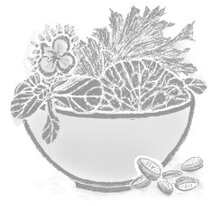ORGANIC Chia flour
partlially de-oiled


- ground from partially dehulled organic chia seeds
- still contains approx. 7g chia oil per 100g
- great for thickening soups and sauces
- vegan, naturally gluten-free and lactose-free
from 158 ratings
This fine flour is made from fresh, edible chia seeds that have been gently de-oiled and ground. It still contains around 7g of chia oil per 100g, as well as vegetable protein and fibre. Ideal for thickening soups and sauces. A daily intake of 15g should not be exceeded. The chia seeds used to make our chia seed flour are naturally gluten free. However, we cannot technically guarantee that they are 100% gluten free (<0.5mg). The flour may contain traces of cereals that contain gluten.
Origin and history
The seeds of the chia plant were valued by the Aztecs, Maya and Incas of Central and South America as a nutrient-rich source of energy and were considered a staple food and remedy in one. The word 'chia', which comes from the Mayan language, also means 'strength'. In Germany and Europe, the small, black South American seeds have become an indispensable ingredient in breakfast cereals and baked goods.
With the extremely high levels of high-quality protein in chia flour and the valuable omega-3 and omega-6 fatty acids, chia seeds provide a wealth of valuable nutrients.
Chia Seeds and Chia Flour
Chia seeds are characterised by a high content of omega-3 fatty acids. This makes it a very valuable source of polyunsaturated fatty acids. Chia flour is particularly suitable for vegan cooking, as it can be used as an egg substitute in baked goods. Soaked in water, it can be used for baking because chia flour forms a gel that slows down the release of carbohydrates and their conversion into sugar. This means that the energy from the food is released more slowly into the body, allowing you to feel fuller for longer and stay that way longer.
Chia is therefore similar to flaxseed. When soaked in water, it forms a gel-like, viscous mass similar to linseed and psyllium. The high water binding capacity and sticky texture of swollen chia seeds has a positive effect on the preparation of dough for bread and bakery products, as it holds the dough together so that it can rise with leavening agents (baking powder and yeast), which is otherwise only known from cereal flours (wheat, rye, spelt).
Recipe

Chia bread
Moist chia bread pairs perfectly with coconut oil or coconut butter as spreads. Keep in the fridge for longer durability. zum RezeptRatings
Specification and ingredients
Chia flour
Average energy and nutrient content for 100 g
Please enjoy our products as part of a diverse and balanced nutrition.
As a product of nature the composition of the oil can vary, the given specifications are therefore average values.
Ingredients
Chia seed flour certified organic.May contain traces of gluten-containing cereals, almonds, hazelnuts, walnuts or sesame.
Maximal erlaubte tägliche Verzehrsmenge
15 g / personDurability
6 - 9 monthsLagerung
Store in a cool and dark place.Fatty acids diagram







 Chia seeds
Chia seeds Pumpkin seed flour
Pumpkin seed flour Hazelnut flour
Hazelnut flour
